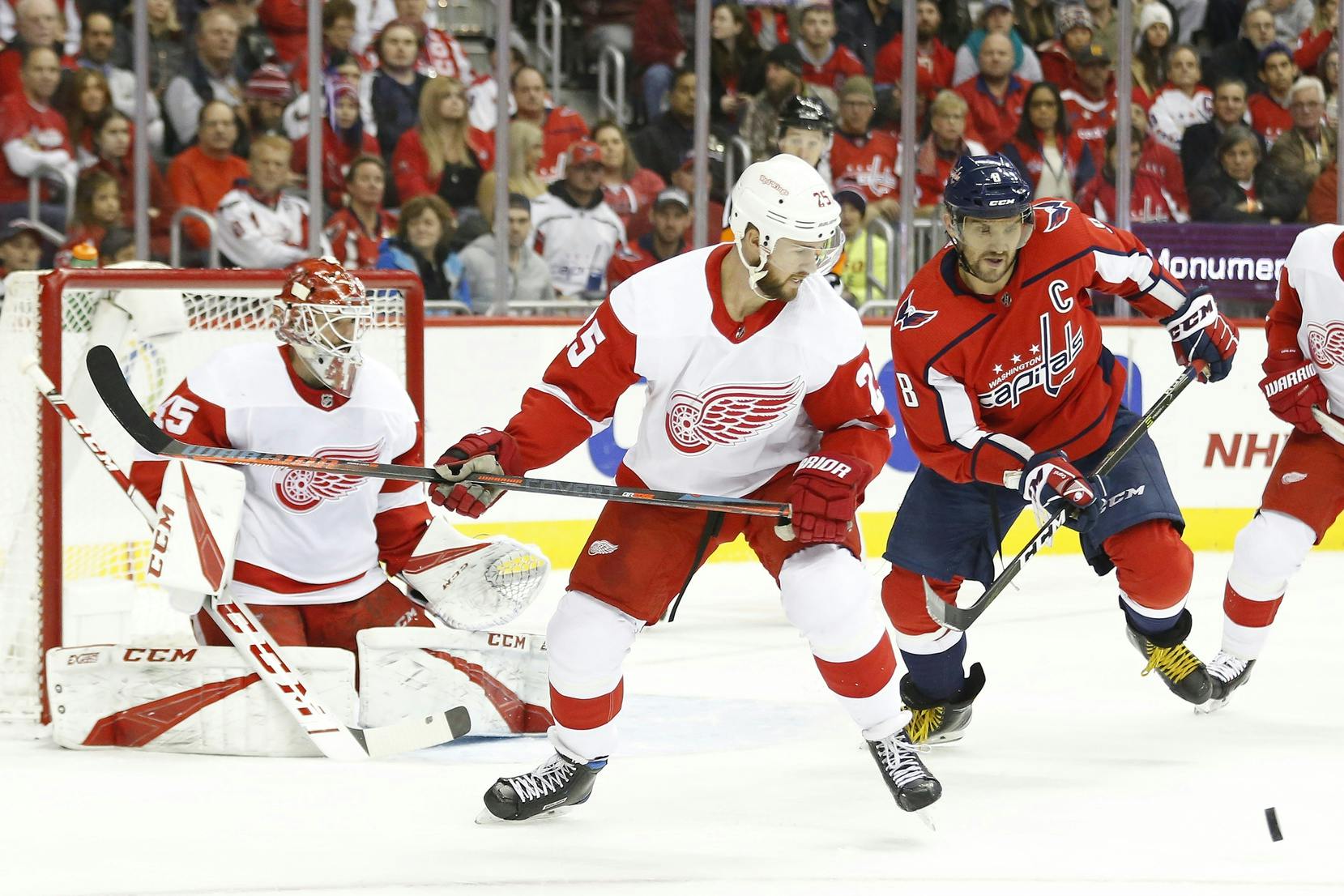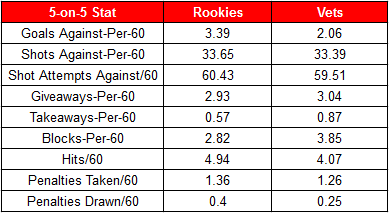By the Numbers: Red Wings Rookie Defensemen vs. The Vets

By Nick Seguin
5 years agoLast week, I wrote about the Red Wings turn of fate after their seven game losing skid to open the season and determined that goaltending was the biggest factor. Since then, though, I’ve seen a lot of chatter online giving credit to the Wings’ latest stretch of wins to the return of veteran defensemen on the blue line. I decided to dive into the numbers and see if there’s any truth to this or if the Wings are better off with the rookies who started the season.

To get to the bottom of this, I pulled all the fancy stats from Corsica.hockey and grouped the defensemen into two groups: under 25-years old and over 25-years-old:
| <25-years-old | >25-years-old |
|---|---|
| Dennis Cholowski – 20 YO | Danny DeKeyser – 28 YO |
| Filip Hronek – 21 YO | Jonathan Ericsson – 34 YO |
| Joe Hicketts – 22 YO | Mike Green – 33 YO |
| Libor Sulak – 24 YO | Nick Jensen – 28 YO |
| N/A | Niklas Kronwall – 38 YO |
| N/A | Trevor Daley – 35 YO |
| AVERAGE AGE: 21.75 | AVERAGE AGE: 32.67 |
I then broke the stats down into two groupings. One of them shows the offensive stats like goals, points, shots, and shot attempts. The other shows the defensive stats, like shots against, giveaways, takeaways, blocks, and hits. I thought it would be interesting to look at penalties taken and penalties drawn as well, so I’ve included those in the defensive stats section.
Because of the small sample size that we have from some of the rookie defensemen, I included the “per-60” stats of each metric and calculated the average for each group. Also, all of the stats pulled are for 5-on-5 play since not all defensemen play the power play or the penalty kill. I believe this gives us a fair and unbiased look at all of the underlying stats for these defensemen.
So let’s jump into it.
OFFENSE
First, let’s look at the differences in offense.

It’s immediately clear that the presence of veteran defensemen in the lineup aided the Red Wings offensive charge. They more than doubled the goals output by the rookies and almost doubled the points output. This is driven mostly by Mike Green’s 1.64 points-per-60, but all of the veteran defensemen have been contributing to the offense in one way or another. Niklas Kronwall and Trevor Daley are the only two without a goal at 5-on-5, but they’ve contributed assists. The rookies only had two players record points at 5-on-5 in Dennis Cholowski (2G, 2A) and Filip Hronek (0G, 2A). Hicketts and Sulak were held pointless.
What’s interesting is that the rookies put up a higher volume of shots on net and a much higher volume of shot attempts. They were hungry and they played with a lot of energy, but they were definitely lacking the experience that comes from playing years in the league that tells you where to shoot from and when. As such, most of their shots came from the outside and normally from the same spot on the blueline. If you look at the veteran shot maps from hockeyviz.com, they shoot from a wide array of locations in the offensive zone. The rookies, especially Hicketts, Hronek, and Sulak seemed to keep to their side of the blueline.
Perhaps this was a fear of leaving their position on the ice un-manned, but it was more likely that they just didn’t know when a good time to jump into the play was in the offensive zone. As such, the rookies left an offensive hole on the blue line that was filled when the veterans got healthy and returned to the ice.
DEFENSE
The defensive stats are a little harder to dissect because it’s tough to measure individual performance in the defensive zone. The first three stats in the following table are on-ice stats, which means they are attributed to all of the players on the ice:

Despite the “team nature” of these stats, we can still draw some conclusions. The goals against line is a little misleading because the rookies were getting sub-.900 save percentages from both goalies. Once Howard turned his game around, he started to contribute greatly to the veteran’s goals against metric. From a shooting perspective, there isn’t much difference between both groups of defensemen. Their shots against/60 are pretty much the same and the vets are shaving off an extra shot attempt per 60 minutes, which is obviously a good thing.
The rest of the stats show a slight improvement in favor of the veterans. They have been giving the puck away more, which is driven by the insanely high 5.9 giveaways/60 by Jonathan Ericsson. On the flip side, Ericsson has the most takeaways/60 than any other defenseman. He continues to be a polarizing player.
The vets also show more of a tendency to block shots, which is of great aid to their goaltender. What this stat tells me, though, is they are able to get in front of the shooter before they get the puck off their stick, whereas the rookies can get caught chasing the puck and are therefore not in position to make the block. Sulak and Hronek were the smallest contributers here, each with less than two blocks/60 while every other defenseman (except for one) in both groups is over three.
Finally, there’s the matter of taking penalties. There isn’t a huge difference in the stat line above, but Filip Hronek has a team-leading 3.7 penalties per 60 minutes. There was definitely a fight in there, but Hronek took way too many penalties for an NHL defensemen, especially considering four of the six veterans are below 1.5.
CONCLUSION
In conclusion, I think it’s fair to say that the return of the Red Wings veteran defensemen has contributed to their latest stretch of wins. I was wrong in saying goaltending was the only reason, though it was a very big one.
The veteran defensemen have infused the team with offense, allowing them to score more goals and win more games. Defensively, they are more responsible away from the puck than the rookies and do a better job of smothering the opposition.
Cholowski getting to play with them first hand is an invaluable experience for him. As the team continues to roll with the punches this season, the vets are bound to get injured again. When they do, it will be interesting to see who from Grand Rapids gets the call-up. Whoever it is will gain a step ahead of his peers as he refines his game at the NHL level and learns from the experience of those around him.
The next crop of defensemen are banging on the door and they’re almost good enough to break it down.
Recent articles from Nick Seguin





